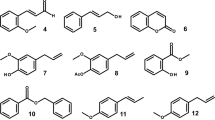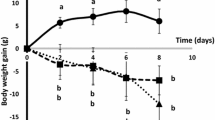Abstract
Nutmeg (Myristica fragrans) is widely used to flavour sweet and savoury foods and has been used as a herbal medicine to enhance appetite in Asian countries. Nutmeg oil contains compounds such as myristicin and methyl eugenol. Previously, we found that inhalation of phenylpropanoid compounds increased appetite in mice. These volatile aroma compounds with appetite-enhancing effects have attracted the attention of healthcare professionals who care for older people with dementia because many of these older people have hypophagia, which leads to frailty and becoming bedridden. Thus, appetite-enhancing agents that are inexpensive and easy to administer are particularly desirable. In this study, we showed that the inhalation of nutmeg oil, myristicin and methyl eugenol produced appetite-enhancing effects in mice. Methyl eugenol alone has shown appetite-enhancing effects and locomotor-reducing effects at the same dose. In a previous study, benzylacetone produced those two effects at the same dose and also increased the body weight of mice significantly; methyl eugenol, however, did not because the mice experienced olfactory habituation after repeated inhalations of methyl eugenol. A structure–activity study showed that a carbonyl group on the aliphatic chain prevented habituation to aroma compounds, which is important information for identifying suitable phenylpropanoid compounds for long-term treatment of loss of appetite.









Similar content being viewed by others
References
Li SZ (2010) Bencao gangmu. In: Li ZM, Ni TY (eds) Jiangsu Renmin Chubanshe, Nanjing, p 179
Jukić M, Politeo O, Miloš M (2006) Chemical composition and antioxidant effect of free volatile aglycones from nutmeg (Myristica fragrans Houtt.) compared to its essential oil. Croat Chem Acta 79:209–214
Ogawa K, Ito M (2016) Appetite-enhancing effects of trans-cinnamaldehyde, benzylacetone and 1-phenyl-2-butanone by inhalation. Planta Med 82:84–88
Ogawa K, Ito M (2016) Appetite-enhancing effects of curry oil. Biol Pharm Bull 39:1559–1563
Park M, Song JA, Lee M, Jeong H, Lim S, Lee H, Kim CG, Kim JS, Kim KS, Lee YW, Lim YM, Park YS, Yoon JC, Kim KW, Hong GS (2018) National study of nutritional status of Korean older adults with dementia who are living in long-term care setting. Jpn J Nurs Sci 15:318–329
Egawa H, Beppu S, Yamamura C, Kurose M, Yagi M, Yamada Y (2008) An investigation into nursing care food at nursing care insurance institutions in Niigata City. J Jpn Soc Masticatory Sci Health Promot 17:16–26
Umegaki H (2014) Sesshokushogai. Ronen Seishin Igaku Zasshi 25(special issue-1):98–102
Ogawa K, Ito M (2016) Appetite-enhancing effects: the influence of concentrations of benzylacetone and trans-cinnamaldehyde and their inhalation time, as well as the effect of aroma, on body weight in mice. Biol Pharm Bull 39:794–798
Ministry of Health, Labour and Welfare (2016) The Japanese pharmacopoeia seventeenth edition (JPXVII). Jiho, Tokyo, p 122
Ito M, Toyoda M, Yuba A, Honda G (1999) Genetic analysis of nothoapiol formation in Perilla frutescens. Biol Pharm Bull 22:598–601
Ogawa K, Yabe H, Kitayama T, Ito M (2016) Locomotor-reducing activity of sesquiterpenes related to Zingiber zerumbet essential oil and hexahydrozerumbone derivatives. Biol Pharm Bull 39:1077–1080
Miyoshi T, Ito M, Kitayama T, Isomori S, Yamashita F (2013) Sedative effects of inhaled benzylacetone and structural features contributing to its activity. Biol Pharm Bull 36:1474–1481
Dalton P (2000) Psychophysical and behavioral characteristics of olfactory adaption. Chem Senses 25:487–492
Wuttke MS, Tompkins L (2000) Olfactory adaption in Drosophila larvae. J Neurogenet 14:43–62
Johnston RE, Derzie A, Chiang G, Jernigan P, Lee HC (1993) Individual scent signatures in golden hamsters: evidence for specialization of function. Anim Behav 45:1061–1070
Chuah MI, Tennent R, Jacobs I (1995) Response of olfactory Schwann cells to intranasal zinc sulfate irrigation. J Neurosci Res 42:470–478
Weinberg MS, Bhatt AP, Girotti M, Masini CV, Day HEW, Campeau S, Spencer RL (2009) Repeated ferret odor exposure induces different temporal patterns of same-stressor habituation and novel-stressor sensitization in both hypothalamic–pituitary–adrenal axis activity and forbrain c-fos expression in the rat. Endocrinology 150:749–761
Tanaka C, Kato R (2007) New pharmacology, 5th edn. Nankodo, Tokyo, pp 204–223
Morimoto T, Kanosue K (2005) An introduction to human physiology. Nankodo, Tokyo, pp 178–179
Ogawa K, Miyoshi T, Kitayama T, Ito M (2014) Locomotor-reducing effects and structural characteristics of inhaled zerumbone and tetrahydrozerumbone derivatives. Biol Pharm Bull 37:1559–1563
Srivastava AK, Srivastava SK, Syamsundar KV (2005) Bud and leaf essential oil composition of Syzygium aromaticum from India and Madagascar. Flavour Fragr J 20:51–53
Giordani R, Regli P, Kaloustian J, Portugal H (2006) Potentiation of antifungal activity of amphotericin B by essential oil from Cinnamomum cassia. Phytother Res 20:58–61
Ogawa K, Tashima A, Sadakata M, Morinaga O (2018) Appetite-enhancing effects of vanilla flavours such as vanillin. J Nat Med 72:798–802
Acknowledgements
We would like to thank Mr. T. Yokokura of Nippon Funmatsu Yakuhin Co., Ltd. for supplying us with the nutmeg powder.
Author information
Authors and Affiliations
Corresponding author
Ethics declarations
Conflict of interest
The authors declare that they have no conflict of interest.
Additional information
Publisher's Note
Springer Nature remains neutral with regard to jurisdictional claims in published maps and institutional affiliations.
Rights and permissions
About this article
Cite this article
Ogawa, K., Ito, M. Appetite-enhancing effects of nutmeg oil and structure–activity relationship of habituation to phenylpropanoids. J Nat Med 73, 513–522 (2019). https://doi.org/10.1007/s11418-019-01295-7
Received:
Accepted:
Published:
Issue Date:
DOI: https://doi.org/10.1007/s11418-019-01295-7




